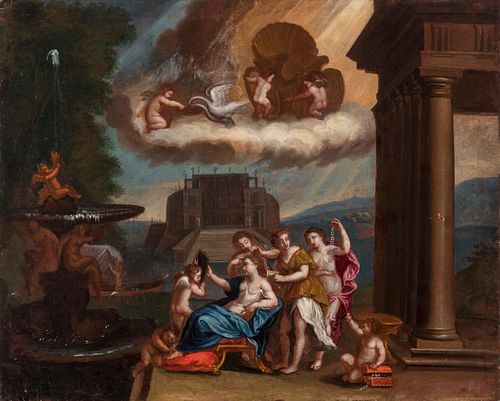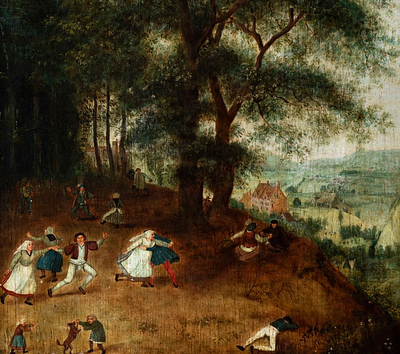FRANCESCO ALBANI´s school; (Bologna, 1578 –1660); 17th century. "The bath of Venus". Oil on canvas. Relined.
Lot 93
About Seller
Setdart Auction House
Carrer Aragó 346
Barcelona
Spain
Setdart Subastas was born in 2004 and is currently the first online art auction in Spain with solidity, prestige and reliability guaranteed by our more than 60,000 users. Setdart has a young, dynamic and enterprising team ready to successfully manage the purchase and sale of art works through custom...Read more
Estimate:
EUR€3,000 - EUR€4,000
$3,225.81 - $4,301.08
Absentee vs Live bid
Two ways to bid:
- Leave a max absentee bid and the platform will bid on your behalf up to your maximum bid during the live auction.
- Bid live during the auction and your bids will be submitted real-time to the auctioneer.
Bid Increments
| Price | Bid Increment |
|---|---|
| EUR€0 | EUR€10 |
| EUR€200 | EUR€25 |
| EUR€500 | EUR€50 |
| EUR€1,000 | EUR€100 |
| EUR€3,000 | EUR€200 |
| EUR€5,000 | EUR€500 |
| EUR€10,000 | EUR€1,000 |
| EUR€20,000 | EUR€2,000 |
| EUR€50,000 | EUR€5,000 |
About Auction
By Setdart Auction House
Jun 30, 2021
Set Reminder
2021-06-30 08:30:00
2021-06-30 08:30:00
America/New_York
Bidsquare
Bidsquare : Old Masters
https://www.bidsquare.com/auctions/setdart-auction-house/old-masters-7134
Setdart Auction House sofia@setdart.com
Setdart Auction House sofia@setdart.com
- Lot Description
FRANCESCO ALBANI´s school; (Bologna, 1578 –1660); 17th century. "The bath of Venus". Oil on canvas. Relined. Presents repaints and holes, with stunned varnish. Measures: 65 x 81 cm. In this oil on canvas painting, the painter presents a theme that is aesthetically inspired by Greco-Latin mythology. The image is starred by a group of women located in the center of the composition, which offer different elements to the woman who is lying on a divan. The painting takes place in a landscape environment, although two scenes can be seen inscribed in the same composition. In the lower area, as already mentioned, a group of women. One of them stands out carrying a portrait which shows the protagonist of the group. This characteristic, added to the upper elements, in which we see a chariot with two cinemas, in allusion to the transport of the goddess Venus, give rise to establish the theme of the work. This theme alludes to a future wedding between different royal courts, since in the case of weddings arranged with brides and grooms from different territories, it was normal to show portraits in order to get to know the future consort. Formally, this work is dominated by the influence of the Roman-Bolognese classicism of the Carracci and their followers, one of the two great currents of the Italian Baroque, together with Caravaggio's naturalism. Thus, the figures are monumental, with idealized faces and serene and balanced gestures, in an idealized representation based on classical canons. Also the rhetoric of the gestures, theatrical and eloquent, clearly baroque, is typical of the Italian classicism of the XVII century. It is also worth mentioning the importance of the chromatic aspect, very thoughtful, intoned and balanced, centered on basic ranges around red, ochre and blue. Also the way of composing the scene, with a circular rhythm and closed on one side while opening to landscape on the other, is typical of this school of baroque classicism. However, despite the dominance of the classic, a certain influence of naturalism can be noticed, especially in the lighting aspect. Thus, although the light is natural, it is directed, focused on the main scene and leaving the rest in semi-darkness, thus differentiating the different planes of space and focusing the viewer's attention on the scene. It should be noted that due to its technical characteristics the work is close to the painting of Francesco Albani, who moved to Rome, where he came into contact with Annibale Carraci, becoming one of his most prominent apprentices.
- Shipping Info
-
In-house shipping available. Please inquire at admin@setdart.com.
-
- Buyer's Premium



 EUR
EUR CAD
CAD AUD
AUD GBP
GBP MXN
MXN HKD
HKD CNY
CNY MYR
MYR SEK
SEK SGD
SGD CHF
CHF THB
THB

















